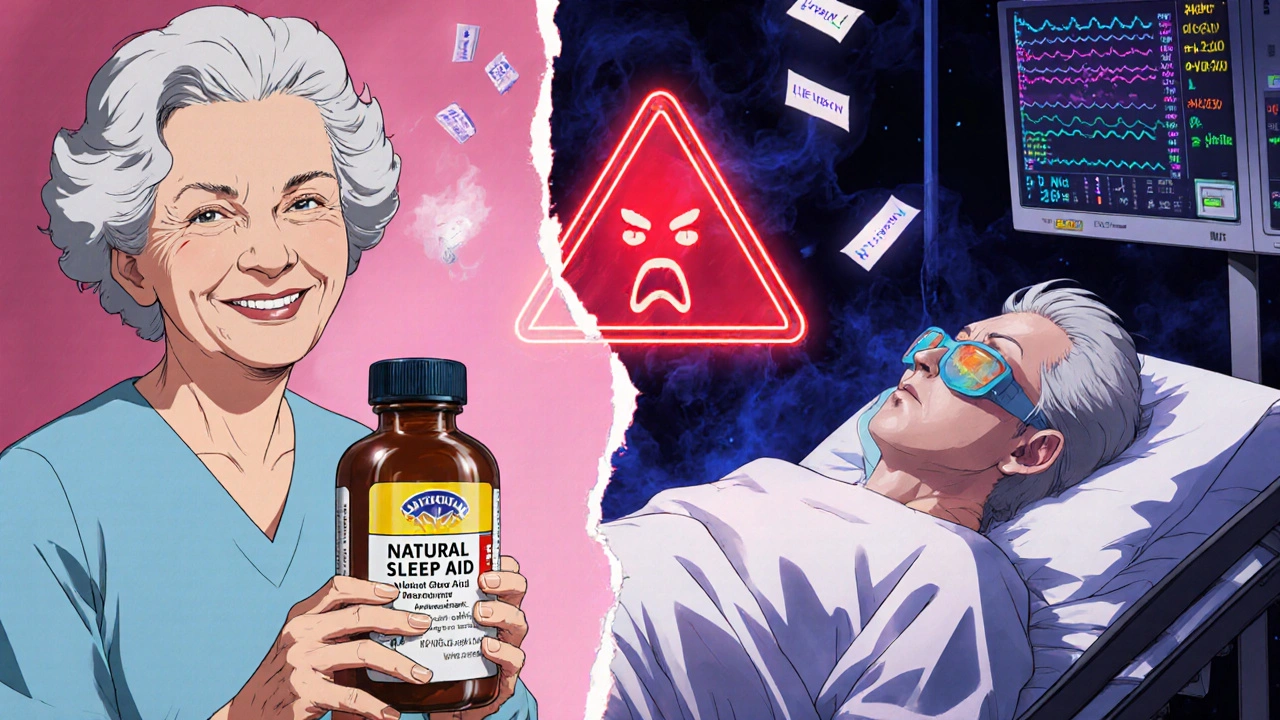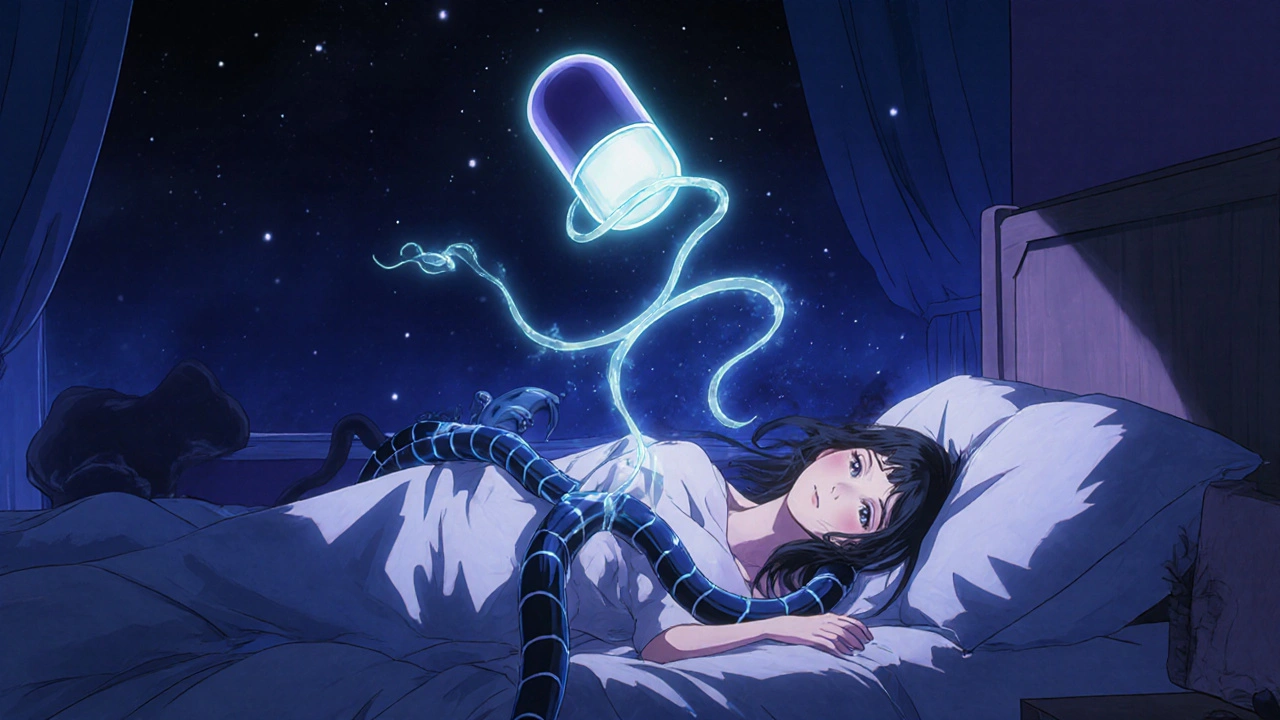Melatonin-Sedative Risk Calculator
Assess Your Medication Combination Risk
This tool helps you understand the potential risks of combining melatonin with other sedatives based on the article's research.
Your Medications
Risk Assessment
Enter your medication details above to get a risk assessment based on the article's research.
It’s easy to think of melatonin as just a gentle sleep aid-something natural, harmless, even safe to mix with your prescription sleep meds. But that’s where things get dangerous. If you’re taking melatonin along with benzodiazepines, zolpidem, or even antidepressants that cause drowsiness, you’re not just doubling your sleepiness. You’re multiplying it. And that can land you in the hospital-or worse.
Why Melatonin Isn’t as Safe as You Think
Melatonin is a hormone your body makes naturally to signal it’s time to sleep. When you take it as a supplement, you’re giving your system an extra push. But unlike prescription sleep drugs, melatonin isn’t tightly regulated in the U.S. You can buy it at any pharmacy, grocery store, or online without a prescription. That doesn’t mean it’s harmless.The problem? Melatonin doesn’t just work on sleep clocks. It also affects brain receptors tied to sedation-GABA-B and opioid receptors-making it interact with many common medications. A 2020 study in the Journal of Clinical Sleep Medicine found that combining melatonin with benzodiazepines like diazepam increases the risk of respiratory depression by nearly 50%. That’s not a small bump. That’s a red flag.
Even if you’re only taking 1mg or 2mg of melatonin, it’s enough to turn a mild sedative into something much stronger. Dr. Neil Stanley, a UK sleep expert with over 35 years of experience, puts it plainly: "The additive effects aren’t linear-they’re multiplicative. Two mild sedatives together can create effects equivalent to a much stronger single sedative."
What Happens When Melatonin Meets Prescription Sedatives
Let’s look at the most common combinations people try-and what actually happens.- Melatonin + Zolpidem (Ambien): Zolpidem reduces how long it takes to fall asleep by about 22 minutes. Melatonin? Only 4 minutes. But when you combine them, the risk of next-day grogginess, confusion, or even sleepwalking jumps dramatically. One Reddit user reported waking up 14 hours later with no memory of the night after taking 3mg melatonin with 0.5mg alprazolam.
- Melatonin + Benzodiazepines (diazepam, lorazepam): These are powerful CNS depressants. Add melatonin, and the chance of breathing problems goes up by 47%. Older adults are especially at risk. The American Geriatrics Society’s 2023 Beers Criteria says this combo increases fall risk by 68% compared to either drug alone.
- Melatonin + Antidepressants (e.g., trazodone, mirtazapine): Many antidepressants cause drowsiness as a side effect. Mixing them with melatonin can leave you feeling like you’ve been hit by a truck the next morning. Some users on Drugs.com reported extreme fatigue, dizziness, and even blurred vision.
- Melatonin + Opioids (codeine, oxycodone): This combo is especially risky. Both slow breathing. Together, they can cause life-threatening respiratory depression. The FDA has flagged this as a high-priority interaction.
Real-world data backs this up. A 2022 survey by ConsumerLab.com of 1,200 supplement users found that 28% had mixed melatonin with prescription sedatives without talking to a doctor. Of those, 37% experienced unintended oversedation. Four percent ended up needing emergency care.
Who’s Most at Risk?
You might think this only affects older adults or people with chronic conditions. But the truth? Anyone taking sedatives-whether for sleep, anxiety, or pain-is at risk.Older adults are the most vulnerable. Their bodies process drugs slower. Their brains are more sensitive to CNS depression. That’s why the American Geriatrics Society specifically warns against melatonin use in seniors who are already on benzodiazepines.
But younger people aren’t safe either. A 2023 post on Inspire, a patient forum, described a car accident after someone took their usual 2mg melatonin with zolpidem. "I woke up in a ditch three miles from home," they wrote. No memory of driving. No memory of the crash. Just a dazed, injured person in the middle of nowhere.
Even people who think they’re being careful-taking melatonin at night and their sedative earlier-are still at risk. The effects don’t disappear just because you spaced them out. Melatonin’s half-life is short (20-50 minutes), but its sedative effects can last up to 8 hours. That’s why the Mayo Clinic recommends waiting at least 5 hours between doses. But even that’s not enough for everyone.

How to Stay Safe: Practical Rules
If you’re taking any sedative-prescription or not-here’s what you need to do:- Don’t combine them unless your doctor says it’s okay. Even if your pharmacist says "it’s fine," ask for a written plan. Many pharmacists aren’t trained to catch these interactions.
- If you must combine them, reduce both doses. The American Academy of Sleep Medicine recommends lowering melatonin to 0.3-0.5mg and cutting your sedative dose by at least 25%. Start low. Go slow.
- Allow 8 hours for sleep. Most sedatives recommend 7 hours. Add melatonin? Push it to 8. That gives your body time to clear the drugs before you try to drive, operate machinery, or even walk around safely.
- Check all your meds. Your doctor should screen you for 14 medication classes before approving melatonin: benzodiazepines, non-benzodiazepine hypnotics, opioids, antidepressants, antipsychotics, antihistamines, muscle relaxants, and more. If they don’t ask, ask them.
- Use prolonged-release melatonin if possible. A 2023 study in Sleep Medicine Reviews found that time-released formulations reduce interaction risks by 31% compared to immediate-release versions. Look for brands labeled "extended-release" or "prolonged-release."
What to Do If You’ve Already Mixed Them
If you’ve taken melatonin with a sedative and feel dangerously drowsy-slurred speech, confusion, slow breathing, or inability to stay awake-call emergency services immediately. Don’t wait. Don’t try to sleep it off. Respiratory depression can be silent and deadly.If you’ve had a bad reaction but aren’t in immediate danger, call your doctor or pharmacist. Tell them exactly what you took, how much, and when. Write it down. People often forget details under stress.
And if you’ve been combining them for months? Don’t quit cold turkey. Talk to your doctor about tapering off one or both. Withdrawal from sedatives can be dangerous. Melatonin doesn’t cause dependence, but your body might have adapted to the combo.

The Bigger Picture: Why This Keeps Happening
The melatonin market is booming. It was worth $743 million in 2022 and is expected to hit $1.42 billion by 2030. But with that growth comes misinformation. A 2023 National Sleep Foundation survey found that 78% of U.S. adults believe melatonin is safe to combine with other sleep aids.That’s not just wrong-it’s deadly. Meanwhile, healthcare providers are catching on. In 2018, nearly half of primary care doctors were okay with combining melatonin and sedatives. By 2023, that number dropped to 22%. The American Academy of Sleep Medicine now classifies this combo as "conditionally recommended against"-except in monitored sleep clinics.
And there’s good news: alternatives are working better. Cognitive Behavioral Therapy for Insomnia (CBT-I) is now the first-line treatment for chronic sleep problems, according to the American College of Physicians. It’s more effective than any pill, with no risk of interactions. And it lasts longer.
If you’re struggling with sleep, talk to your doctor about CBT-I. It’s covered by many insurance plans. It doesn’t require pills. And it doesn’t put you at risk of waking up in a ditch.
What’s Changing in 2025
The FDA is finally stepping in. In 2023, they released draft guidelines requiring all melatonin products to carry clear warnings about sedative interactions by Q2 2024. The European Medicines Agency already requires it. Labels will soon say: "Do not use with sedatives. Risk of severe drowsiness and breathing problems."Manufacturers are also starting to reformulate. More brands are switching to prolonged-release versions to reduce peak concentrations. And pharmacies are updating their interaction checkers. The National Sleep Foundation’s tool now flags 87 high-risk combinations involving melatonin.
This isn’t just about labels. It’s about awareness. You can’t trust marketing. You can’t trust what you read on Reddit. You can’t trust your instincts. If you’re on a sedative, melatonin isn’t a "natural" upgrade-it’s a dangerous gamble.
Can I take melatonin with my sleeping pill?
Only if your doctor explicitly says it’s safe-and even then, only under strict conditions. Most doctors now advise against combining melatonin with prescription sleep aids like zolpidem or benzodiazepines. The risk of excessive drowsiness, impaired coordination, and breathing problems is too high. If you’re considering it, talk to your doctor first. Never assume it’s safe just because melatonin is "natural."
How long should I wait between melatonin and a sedative?
The Mayo Clinic recommends at least a 5-hour gap. But that’s the bare minimum. For safety, aim for 8 hours between doses. Melatonin’s effects can last up to 8 hours, and sedatives linger even longer. If you’re taking both, you need a full night’s sleep to clear them safely. Driving or operating machinery within 8 hours of taking either is risky.
Is melatonin safer than prescription sleep drugs?
In isolation, yes. Melatonin has a lower risk of dependence, withdrawal, and next-day impairment than drugs like Ambien or Xanax. But that doesn’t mean it’s safe to mix. When combined with sedatives, melatonin makes those risks much worse. The real safety advantage comes from using melatonin alone-or better yet, using non-drug approaches like CBT-I.
What are the signs I’ve taken too much melatonin with a sedative?
Extreme drowsiness, confusion, slurred speech, slow or shallow breathing, dizziness, inability to wake up, or memory loss after taking the combo are all red flags. If you or someone else is showing these signs, call emergency services immediately. Don’t wait. Respiratory depression can happen quietly and become fatal within minutes.
Are there any melatonin brands that are safer to combine with sedatives?
No brand is safe to combine with sedatives. But prolonged-release (extended-release) formulations reduce interaction risks by about 31% compared to immediate-release versions because they release melatonin more slowly. If you must use melatonin with a sedative (and only if your doctor approves), choose a prolonged-release version and keep the dose at 0.3-0.5mg. Still, the safest choice is to avoid the combo entirely.
What should I do instead of mixing melatonin and sedatives?
Talk to your doctor about Cognitive Behavioral Therapy for Insomnia (CBT-I). It’s the most effective long-term treatment for chronic sleep problems, with no side effects or drug interactions. It’s covered by most insurance plans. If you need short-term help, your doctor can adjust your current medication safely. Don’t reach for melatonin as a "natural fix"-it’s not a fix at all when sedatives are involved.
Final Takeaway
Melatonin isn’t the harmless sleep aid it’s made out to be-especially when mixed with other sedatives. The risks aren’t theoretical. People are waking up in ditches, in hospitals, and not waking up at all. The science is clear. The warnings are out there. The FDA is finally acting. You don’t need to guess. You don’t need to risk it.If you’re on a sedative, skip the melatonin. If you’re thinking about trying it, talk to your doctor first. And if you’ve already mixed them? Stop. Assess. Get help. Your sleep matters. But your safety matters more.

